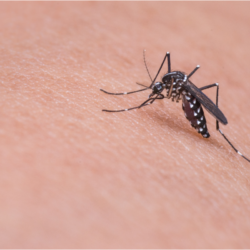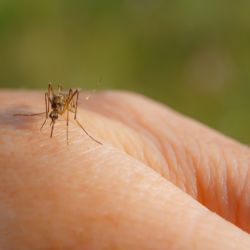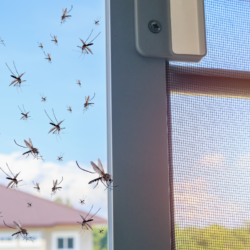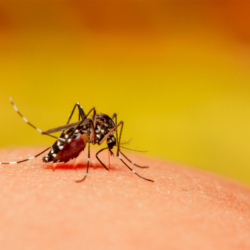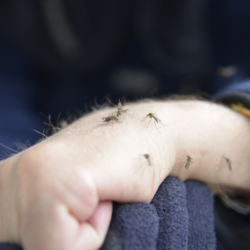At a time when mosquito bites are posing increased health risks, due to the expansion of mosquito habitats and the emergence of new diseases linked to climate change, the need to protect oneself is paramount. At the heart of this concern is the choice of an effective anti-mosquito bracelet as a practical, modern solution.
In this article, we’ll guide you through the essential criteria for choosing the right mosquito repellent bracelet. As well as being practical and aesthetically pleasing, this accessory provides an essential barrier against mosquito bites. We’ll look at the different types of wristband available on the market, highlighting the importance of their components, the length of protection they offer, and other aspects such as waterproofing and design.
The aim is to provide you with comprehensive, reliable information so that you can make an informed choice, tailored to your specific needs and lifestyle. Whether it’s for outdoor activities, travel to high-risk areas, or simply for everyday use during the summer months, choosing the right mosquito repellent bracelet is a crucial step for your well-being and health.
The impact of climate change on mosquitoes
A. Expansion of habitats
Climate change is having a considerable impact on mosquito habitats, altering their geographical distribution and population density. Increases in temperature and variations in precipitation create favourable conditions for the expansion of mosquitoes into previously inhospitable regions. For example, higher temperatures can accelerate the life cycle of mosquitoes, reducing the time taken for them to reach adulthood and thus increasing the number of generations per season. Similarly, increased rainfall and humidity can widen the available breeding areas, allowing mosquito populations to grow.
This expansion of habitats leads to increased contact between mosquitoes and human populations, particularly in urban and peri-urban areas. This increases the risk of disease transmission in areas where they were previously rare or non-existent. As a result, diseases such as dengue fe ver and the Zika virus could spread to temperate zones that were previously spared.
B. New species and diseases
Climate change is also encouraging the migration and establishment of new mosquito species in regions where they were not previously present. This introduction of new species can disrupt local ecosystems and increase the diversity of pathogens transmitted by mosquitoes. For example, the arrival of the Aedes albopictus species, also known as the tiger mosquito, in new regions has been associated with epidemics of diseases such as dengue fever and chikungunya.
Environmental changes can also influence the evolution of new pathogens or the re-emergence of old diseases. Mosquitoes, as vectors, play a crucial role in this process. Altered climatic conditions can affect the ability of mosquitoes to transmit viruses and parasites, potentially increasing their effectiveness as vectors or altering the range of diseases they are capable of transmitting.
Ongoing monitoring of mosquito populations, as well as research into the interactions between mosquitoes, the pathogens they transmit, and the environment, are essential to understanding and mitigating the impact of climate change on public health. Efforts must include vector prevention and control, surveillance of emerging diseases and raising public awareness of the risks associated with these changes.
The risks of mosquito bites
A. Immediate risks
Mosquito bites can cause immediate reactions ranging from mild to severe. The most common reaction is slight redness and swelling around the bite, accompanied by itching. These symptoms are generally due to an allergic reaction to the mosquito saliva injected during the bite. In some cases, individuals may develop more severe reactions, such as extreme itching, skin rashes or even hives. These symptoms are usually temporary and disappear within a few days.
A major concern is the possibility of a severe allergic reaction, known as anaphylaxis. Although rare, anaphylaxis can be an emergency medical condition, requiring immediate intervention. It is characterised by symptoms such as difficulty in breathing, swelling of the throat and a sharp drop in blood pressure, and can lead to anaphylactic shock. It is crucial for people with a history of severe allergic reactions to insect bites to carry an emergency kit with them, containing medicines such as epinephrine (adrenaline).
B. Long-term risks
In addition to immediate reactions, mosquito bites can entail significant long-term risks. The main danger lies in the transmission of various infectious diseases. These diseases, such as malaria, dengue fever, Zika virus, yellow fever and West Nile virus, can have serious health consequences, ranging from mild symptoms to potentially fatal illnesses.
Malaria, for example, can lead to serious complications such as severe anaemia and cerebral encephalopathy, which can be fatal, especially in young children and pregnant women. Similarly, dengue fever can progress to a serious form, dengue haemorrhagic fever, characterised by bleeding, low blood platelets and plasma leaks, threatening the patient’s life.
Another long-term risk is the effect of these diseases on public health systems, particularly in regions where they are endemic. Epidemics can overload health systems, affecting not only those suffering from the disease but also access to care for other conditions.
Finally, it is important to highlight the long-term psychological and social impact of these diseases. Affected individuals can face challenges in terms of quality of life, ability to work, and social isolation, particularly in the case of chronic illnesses or those with long-term sequelae.
Preventing mosquito bites and combating their spread are therefore essential to minimise these risks and protect public health.
What is an anti-mosquito bracelet?
The anti-mosquito bracelet has been in the news for almost a decade now. It owes its success to its ease of use, its subtlety and, of course, its proven effectiveness against these little flying pests. This jewel attaches discreetly to the wrist and is worn for hours, keeping mosquitoes and other flying insects at bay. And it does all this effortlessly, without giving off any strong or unpleasant odours, and without releasing any potentially harmful micro-particles into the atmosphere.
This is all to the good when you consider that certain sprays, lotions and repellent products in fluid form can cause irritation and allergic reactions on contact with sensitive skin. The anti-mosquito bracelets offered by your online pharmacy are impregnated with natural, non-toxic repellents. Mainly essential oils. So it’s easy to see why this little piece of anti-mosquito wristwear is so popular in summer!
But which mosquito repellent bracelet should you choose? One thing’s for sure: manufacturers design these accessories to ergonomic standards. However, there are a few criteria to consider if you want to find the one that’s right for you!
Choosing your mosquito repellent bracelet
-
The first criterion to take into account when choosing your mosquito repellent bracelet is the repellent formula used:
The Graffic Bracelet Anti Moustique from Parakito, for example, contains the fully-regulated biocide TP 19 Repellent. This includes essential oils of cassia, rosemary and spearmint, plus Geraniol at 91.10 g/kg. Its formula is DEET-free, which means it is free from toxic substances.
-
The duration of protection is also an essential point:
It varies greatly from one model to another. Commercially available mosquito repellent bracelets will last from a few days to several weeks after the first use.
That said, with a rechargeable mosquito repellent bracelet, you can be sure of being protected indefinitely. Obviously, it costs a little more than a standard mosquito repellent bracelet. Especially as a refill can last up to 15 days. While the price is not a decisive factor in your choice, the refills and the duration will make all the difference.
-
Waterproofness is a factor to be taken into account if you enjoy water activities:
Whether you want to swim in the ocean, cool off by a fountain, go kayaking or ride the waves on a surfboard, Waterproof mosquito repellent bracelets are a must. You’ll need to pack them in your suitcase!
-
Don’t forget the design:
Elegant, colourful, fun or sporty… There’s a wide range of models, shapes and colours to choose from. So you’ll have no trouble finding the mosquito repellent bracelet that suits your style and your taste in clothes! There ‘ s something for everyone!
You should also know that there are also ultrasound anti-mosquito bracelets like the ZeroZzz Flexy bracelet. These don’t contain any chemical or natural substances, but rather electronic repellents that keep mosquitoes away by emitting low-pitched sounds that vary in intensity. This model of ZeroZzz Flexy is made of plastic and comes in three colours (blue, black and red).
Some people prefer to place their bracelets elsewhere than around their wrists, but their function will be just as effective. Hang it on your rucksack, the handlebars of your bike, the steering wheel of your car, etc. You don’t have to wear it on your wrist.
Steps you can take today to keep mosquitoes at bay
As well as using mosquito repellent bracelets, there are other things you can do at home to keep mosquitoes away.
Eliminate areas of stagnant water
Mosquitoes breed in stagnant water, so by eliminating areas of stagnant water in and around your home, you can reduce the mosquito population. This can include emptying rubbish bins, cleaning gutters, draining puddles and cleaning swimming pools and ponds.
Use mosquito repellents
There are many mosquito repellents available on the market, which can be used both inside and outside the home. Mosquito repellents containing DEET are generally the most effective.
Install mosquito nets
Mosquito nets are another effective way of preventing mosquito bites. Mosquito nets can be installed on windows, doors and even beds to keep mosquitoes out.
Avoid going out at dawn or dusk
Mosquitoes are most active at dawn and dusk, so it’s best to avoid going out at these times if possible.
How can I relieve the pain of a mosquito bite?
When bitten by a mosquito, it can be difficult to resist the urge to scratch. However, scratching only aggravates the symptoms by causing further irritation and possible infection. Fortunately, there are several effective ways to relieve the itching and inflammation associated with mosquito bites.
Applying ice or cold to the mosquito bite can help reduce inflammation and relieve itching. To do this, wrap an ice cube in a clean cloth and apply it to the bite for about 10 minutes at a time. Topical creams such as calamine or hydrocortisone can also help relieve itching and inflammation. Simply apply a small amount of cream directly to the bite.
If symptoms are more severe, it may be helpful to take an antihistamine. These drugs help to reduce inflammation and itching. Follow the manufacturer’s instructions for dosage and frequency of use. Lastly, using the Eolesens bite away thermal pen is a very effective way of reducing the release of histamine, without having to resort to medication.



